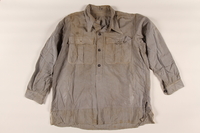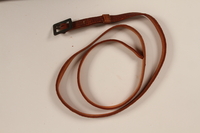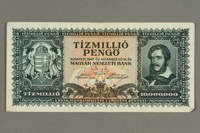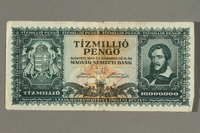Overview
- Description
- The collection documents the Holocaust experiences of Steven Vogel of Budapest, Hungary including his deportations to the Auschwitz-Birkenau and Mauthausen concentration camps and his immigration to the United States in 1945. Included are pre-war identification documents of Steven, his parents Ödön and Vilma (née Deutsch) Vogel, and other relatives in the Vogel and Deutsch families; birth certificates; report cards; immigration paperwork; tax and selective service forms; family history; an oral history interview transcript; restitution claims; and correspondence. Included with the correspondence is a 1946 letter to Steven from Tomi Baratod describing their experiences at Auschwitz.
- Date
-
inclusive:
circa 1859-2009
bulk: 1940-1958
- Credit Line
- United States Holocaust Memorial Museum Collection, Gift of James Vogel
- Collection Creator
- Steven Vogel
- Biography
-
Steven Vogel (formerly István, 1922-2012) was born in Budapest, Hungary, to Vilma (née Deutsch, 1895-1944) and Ödön (Edmond, 1883-1944) Vogel. Vilma was born in Újpest, Hungary, to Rose (née Lichtenstein,?-1935) and Anton Deutsch (?-1909). She had five sisters, and one brother. One of Vilma’s sisters, Szeren (Serena, 1889-1942) was married to Adolf Schwarcz, and they had a daughter, Livia (later Lilly Brust Gach, 1912-2001), and a son, Laszlo (later Leslie Shaw, 1915-1990). Adolf was business partners with Edmond, and introduced him to Vilma. Edmond and Vilma married in October 1921. Edmond was born in Budapest to Katalin (née Mosinger, 1840-1921) and Mor Vogel (1841-1908), and worked as a wholesaler representing the Swiss Movado Watch Company in Hungary, and the surrounding countries. The family lived very comfortably, and employed several full-time staff members in their home. Steven was an only child, but was very close with his numerous cousins. Steven was also close with his 31 classmates, an equal mix of Jewish, Catholic, and Protestant boys. The entire family spoke Hungarian and considered themselves very proud Hungarians. The family was also very religious. Edmond went to the Dohány Street Synagogue every Friday, where he was a member of the board of trustees.
With the appointment of Adolf Hitler as Chancellor of Germany on January 30, 1933, the Nazi party began solidifying political control, and the Hungarian government began building an alliance with Nazi Germany. Starting in 1938, Hungary began passing anti-Jewish laws modeled after Germany’s Nuremberg laws from 1935, which defined Jews in racial terms; excluded them from various professions, restricted their opportunities in economic life, and stripped them of equal citizenship status. Steven was in his last year of high school in 1939, when Germany started World War II by invading Poland on September 1. In November 1940, Hungary officially joined the Axis alliance, and began fighting alongside Germany. Initially, the alliance had little impact on Steven’s life, and he began law school in 1941 while also working with his father in the watch business. As the war progressed, Steven and his family learned that Jews throughout the German-occupied areas of Europe were being persecuted and sent to labor camps, though most news was hidden from them in Hungary. While still in law school, Steven received a permit and visa to immigrate to the United States, but he did not want to leave his father who was sick and needed multiple kidney surgeries. After his father passed away in February 1944, Steven refused to leave his mother alone.
Following Germany’s defeat by the Soviet Union at the Battle of Stalingrad in 1943, Hungary attempted to negotiate an armistice with the Allied powers. In response, German forces occupied Hungary on March 19, 1944. In mid-May, the Hungarian authorities worked with the German Security Police to systematically deport the Hungarian Jews. Steven finished law school, but he was unable to attend his graduation on June 15 because he was arrested on May 23, along with his mother, Vilma. They were both taken to Gestapo headquarters. They falsely accused Steven of listening to British radio, and sending signals to the Allies. Six weeks later, Steven and Vilma were taken to a brick factory where Hungarian Jews were being gathered for deportation to Auschwitz-Birkenau killing center in German-occupied Poland. They arrived at Birkenau after several days packed into a full cattle car with no food, and only a hole in the floor for the bathroom. Their arrival at the camp was the last time Steven saw his mother, as she was immediately sent to the gas chamber and murdered. Steven was selected for forced labor, and he was tattooed with prisoner number A-17192. He was forced to work in a coal mine at Auschwitz I, before being sent to a nearby subcamp in order to work in a factory for Volkswagen.
In April 1945, the Red Army was closing in on the camp, and the Volkswagen factory complex was evacuated. Steven was sent on a forced march through the snow and ice for several days, before being put on a train going to Mauthausen concentration camp in Austria. Any prisoners who could not walk during the march were shot in the head by the SS. Steven arrived at Mauthausen on May 1, and he was given the prisoner number 120424. He was forced to work for an automobile company at Gusen I, a subcamp of Mauthausen, but was only there a few days before American troops liberated the camp on May 5. Upon liberation, Steven learned that the Soviet Union had occupied Hungary, and he did not want to return there. After spending some time in a British military hospital, he decided to make his way to Switzerland. Steven hid on a Red Cross Caravan, and then boarded a transport train for French troops heading there. Once in Switzerland, he met up with one of his cousins and her son who had survived the war in Zurich, as well as some of his father’s business contacts. They convinced Steven to turn himself in for entering the country illegally, at which point he was arrested, and sent to a prison hospital.
The Swiss authorities allowed Steven to meet up with his cousin, Leslie, at the Italian-Swiss border. In 1941, Leslie had immigrated to the United States to join his parents, who had immigrated in 1939, and established a branch of their wholesale watch business in New York. In 1942, Leslie had joined the US Army, and served on the Swiss border as a Staff Sergeant with the 5th Army. Leslie wrote a letter for Steven to take to the US consulate in Zurich, which allowed him to receive his immigration visa to the US. Steven left for New York City on November 3, 1945, aboard the S.S. Marques de Comilla. In America, Steven found out that the majority of his extended family had also been deported to Auschwitz, and he was the only one to survive. In New York, Steven worked as a manager of a large watch house. In August 1953, he met Gloria Jean Fox from Grand Rapids, Michigan, whose family owned several large jewelry stores. They married in Michigan on January 26, 1954, and lived together in New York where they raised their son, James.
Physical Details
- Genre/Form
- Correspondence.
- Extent
-
1 box
2 oversize folders
- System of Arrangement
- The collection is arranged as two series. Series 1. Steven Vogel papers, 1922-2009; Series 2. Vogel family papers, circa 1859-2002 and undated
Rights & Restrictions
- Conditions on Access
- There are no known restrictions on access to this material.
- Conditions on Use
- Material(s) in this collection may be protected by copyright and/or related rights. You do not require further permission from the Museum to use this material. The user is solely responsible for making a determination as to if and how the material may be used.
Keywords & Subjects
- Topical Term
- Jews--Hungary--Budapest. Holocaust, Jewish (1939-1945)--Reparations. Holocaust, Jewish (1939-1945)‐‐Personal narratives. Holocaust, Jewish (1939-1945)--Survivors.
- Geographic Name
- Budapest (Hungary) United States--Emigration and immigration.
- Corporate Name
- Birkenau (Concentration camp) Mauthausen (Concentration camp)
Administrative Notes
- Holder of Originals
-
United States Holocaust Memorial Museum
- Legal Status
- Permanent Collection
- Provenance
- The collection was donated to the United States Holocaust Memorial Museum by James Vogel in 2002. He donated an accretion in 2017.
- Primary Number
- 2002.175.5
- Record last modified:
- 2024-01-25 11:42:05
- This page:
- https://collections.ushmm.org/search/catalog/irn614742
Additional Resources
Download & Licensing
In-Person Research
- Available for Research
- Plan a Research Visit
-
Request in Shapell Center Reading Room
Bowie, MD
Contact Us
Also in Steven Vogel collection
The collection consists of a cotton shirt and a leather belt worn by Steven Vogel as he exited Mauthausen concentration camp upon liberation in April 1945. Steven Vogel took the shirt and belt from an SS storeroom housing clothing and supplies at the camp. Letter: handwritten by Tomi Baratod [sic] in Budapest addressed to "Pistka" [sic], dated December 14, 1946. Letter describes events in Auschwitz concentration camp in Poland after Steven was evacuated from there to Mauthausen concentration camp in Austria. Written by a friend of Steven's who remained in Auschwitz and detailed his experiences, in Hungarian. Film reel: 3 reels of 8mm pre-war Hungarian family footage.
Date: approximately 1945

Shirt taken from an SS storeroom at a concentration camp by a Hungarian Jewish inmate and worn after liberation
Object
Men’s long-sleeved shirt taken from an SS storeroom at Mauthausen concentration camp in Austria, by Steven (István) Vogel and worn for two days after liberation on May 5, 1945. Steven, an only child, grew up in Budapest, Hungary, with his parents Edmond and Vilma. In September 1939, during Steven’s last year of high school, Germany began World War II by invading Poland. In November 1940, Hungary officially joined the Axis alliance and began fighting alongside Germany. Initially, the alliance had little impact on Steven’s life, and he began law school in 1941. In February 1944, his father, Edmond, passed away due to kidney disease. On March 19, German forces occupied Hungary because the nation had tried to negotiate an armistice with the Allies. Steven and his mother were arrested on May 23, and taken to Gestapo headquarters. Steven and Vilma were deported to Auschwitz-Birkenau killing center in German-occupied Poland. Upon their arrival, Vilma was sent to the gas chambers and murdered. Steven was initially selected for forced labor at a coal mine, and then later at a Volkswagen factory. In April 1945, as the Red Army advanced on the region, the factory complex was evacuated. Steven was sent on a forced march through the snow and ice for several days before being put on a train to Mauthausen. Shortly after his arrival, the camp was liberated by American troops. After liberation Steven made his way to Switzerland, before immigrating to the United States on November 3, 1945.

Leather belt taken from an SS storeroom at a concentration camp and worn by a Hungarian Jewish inmate after liberation
Object
Leather belt taken from an SS storeroom at Mauthausen concentration camp in Austria, by Steven (István) Vogel and worn for two days after liberation on May 5, 1945. Steven, an only child, grew up in Budapest, Hungary, with his parents Edmond and Vilma. In September 1939, during Steven’s last year of high school, Germany began World War II by invading Poland. In November 1940, Hungary officially joined the Axis alliance and began fighting alongside Germany. Initially, the alliance had little impact on Steven’s life, and he began law school in 1941. In February 1944, his father, Edmond, passed away due to kidney disease. On March 19, German forces occupied Hungary because the nation had tried to negotiate an armistice with the Allies. Steven and his mother were arrested on May 23, and taken to Gestapo headquarters. Steven and Vilma were deported to Auschwitz-Birkenau killing center in German-occupied Poland. Upon their arrival, Vilma was sent to the gas chambers and murdered. Steven was initially selected for forced labor at a coal mine, and then later at a Volkswagen factory. In April 1945, as the Red Army advanced on the region, the factory complex was evacuated. Steven was sent on a forced march through the snow and ice for several days before being put on a train to Mauthausen. Shortly after his arrival, the camp was liberated by American troops. After liberation Steven made his way to Switzerland, before immigrating to the United States on November 3, 1945.





